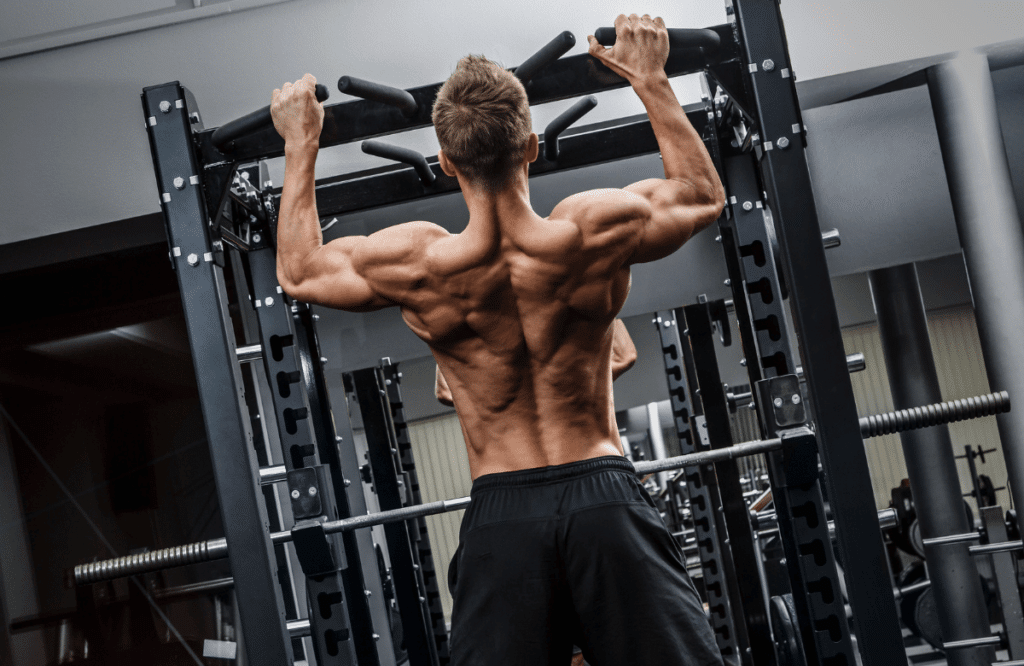A strong and well-developed back is essential for overall strength, posture, and aesthetics. The latissimus dorsi, commonly known as the lats, are the largest muscles in the upper body and play a significant role in achieving a well-rounded physique. By targeting the lats with effective exercises, you can build a stronger back that not only looks impressive but also enhances your overall athletic performance. In this article, we will explore eight of the best workouts for lats to help you achieve your strength goals.
Jump to:
What Are Your Lats?
The latissimus dorsi muscle, commonly referred to as the “lats,” is a large muscle located in the back. It is the broadest muscle in the human body and spans across the middle and lower back region. “Latissimus dorsi” translates to “broadest muscle of the back” in Latin, which accurately describes its shape and size.

Originating from several points, the latissimus dorsi muscle has extensive attachments. Its origins include the spinous processes of the lower thoracic and lumbar vertebrae, the iliac crest (the upper border of the hip bone), the thoracolumbar fascia (a sheet-like connective tissue covering the lower back), and the lower three or four ribs. From these origins, the muscle fibers converge to form a thick tendon that inserts into the humerus (upper arm bone) near the bicipital groove.
What Do The Lats Do?
The latissimus dorsi muscle is responsible for a variety of movements involving the shoulder and upper back. Its primary functions include shoulder extension (pulling the arm back), shoulder adduction (pulling the arm toward the body), and shoulder internal rotation. These actions are commonly observed in exercises such as pull-ups, lat pulldowns, rows, and other movements that involve pulling or rowing motions.
Strong and well-developed lats contribute to overall upper body strength, stability, and posture. They also play a crucial role in sports and activities that involve pulling, such as climbing, swimming, rowing, and throwing. Additionally, developed lats provide an aesthetically pleasing V-shaped appearance to the upper body.
The Benefits of Strengthening Your Lat Muscles
Strengthening your lat muscles, the latissimus dorsi offers several benefits for your overall fitness and well-being. Here are some key advantages of developing and strengthening your lats:
Improved Upper Body Strength
The lats are the largest muscles in the upper body, and strengthening them can significantly enhance your upper body strength. Having strong lats allows you to perform various pulling movements with greater ease, such as pull-ups, rows, and lat pulldowns. This increased strength can extend to other exercises and activities, enabling you to lift heavier weights, perform more challenging exercises, and engage in everyday tasks that require upper body strength.
Enhanced Posture and Spinal Stability
Strong lats contribute to better posture and spinal stability. These muscles help maintain proper alignment and support for the spine, reducing the risk of postural issues, such as rounded shoulders or excessive curvature of the upper back. Strengthening the lats can counteract the effects of prolonged sitting and sedentary lifestyles, promoting a more upright and balanced posture.
Injury Prevention
Well-developed lats can help prevent injuries, particularly those related to the shoulders, upper back, and spine. By strengthening the lats and those surrounding primary muscles, you improve the stability and support of the shoulder joints, reducing the risk of rotator cuff injuries, impingements, and other shoulder-related problems. The lats also work in conjunction with other back muscles to provide stability for the spine and minimize the risk of lower back injuries.

Improved Athletic Performance
Strong lats are essential for various sports and physical activities. Whether you’re a swimmer, climber, golfer, or participate in sports that involve throwing or pulling movements, having well-developed lats can enhance your performance. The lats contribute to power, force production, and overall upper-body coordination, allowing you to generate more strength and efficiency in your athletic endeavors.
Functional Movements
The lat muscles are involved in a wide range of functional movements that we perform in our daily lives. Activities like lifting heavy objects, pulling open doors, carrying groceries, or even pushing a stroller engage the lats to some degree. Strengthening these muscles improves your ability to perform these movements efficiently and with less strain on other muscle groups.
Lat Exercises For Your Routine:
Here is an entire list of lats exercises to try for the most muscle activity and ability to reach physique goals:
1. Deadlift
To perform a deadlift, begin by standing with your feet hip-width apart, toes pointed slightly outward. Position the barbell on the floor in front of you, centered over the middle of your feet. Bend at the hips and knees, keeping your back straight and chest up, to grip the barbell with an overhand grip just outside your legs. Your hands should be shoulder-width apart.
Initiate the lift by driving through your heels, pushing the floor away as you stand up. Keep your back straight and your chest lifted throughout the movement. As you rise, extend your hips forward and pull the barbell up along your legs, maintaining close contact between the bar and your body. Fully extend your hips and knees at the top of the movement, standing tall. To lower the bar, reverse the movement, pushing your hips back and bending at the hips and knees while maintaining control of the barbell. Lower it back to the floor in a controlled manner, ensuring your back remains straight. Repeat for the desired number of repetitions, always prioritizing proper form and technique.
2. Pull-up
Pull-ups are a classic exercise that targets the lats effectively. Grab a pull-up bar with an overhand grip, hands slightly wider than shoulder-width apart, and hang freely. Pull your body up until your chin is above the bar, focusing on engaging your lats throughout the movement. Lower yourself back down in a controlled manner. If you find pull-ups challenging, start with assisted variations or use resistance bands to gradually build strength.
3. T-bar Rows
To begin this lat workout, place one end of a barbell into a landmine attachment or secure it in a corner, load weight plates on the other end, and straddle the bar with your feet shoulder-width apart. Bend your knees slightly, hinge forward from the hips, and grasp the handles with an overhand grip. Pull the barbell toward your chest, leading with your elbows, and squeeze your lats at the top of the movement. Lower the barbell under control and repeat.
4. Bent Over Rows
Bent-over rows primarily target the mid-back but also engage the lats. Stand with your feet shoulder-width apart, hinge forward from your hips, and grasp a barbell with an overhand grip. Keep your back flat and pull the barbell toward your abdomen while squeezing your shoulder blades together. Lower the barbell under control and repeat for the desired number of repetitions. This exercise helps develop overall back thickness and promotes lat development.
5. One-Arm Dumbbell Rows
The one-arm or single-arm dumbbell rows allow for better isolation of the lats. Start by placing your left knee and hand on a bench, with your back parallel to the floor. Hold a dumbbell in your right hand, extend your arm fully, and pull the weight towards your chest, focusing on contracting the lat muscle. Lower the dumbbell under control and repeat for the desired reps before switching sides. This exercise helps address muscle imbalances and improves overall lat development.
6. Seated Cable Rows
Seated cable rows are an effective exercise for targeting the lats and the entire back. Sit on a cable row machine with your feet resting on the platform, grasp the handles with an overhand grip, and keep your back straight. Pull the handles toward your torso while maintaining an upright posture and squeezing your shoulder blades together while keeping your core tight. Slowly return to the starting position, feeling the stretch in your lats, and repeat the movement.
7. Lat Pulldown
Lat pulldowns are a great exercise for targeting the lats, especially for beginners or those who struggle with pull-ups. Sit at a lat pulldown machine, grasp the bar with a wide overhand grip, and pull it down towards your chest while keeping your back straight. Squeeze your lats at the bottom of the movement, and then slowly return the bar to the starting position. Vary your grip width to target different areas of the lats.
8. Inverted Rows
Inverted rows, also known as bodyweight rows or Australian pull-ups, are an effective bodyweight exercise for targeting the lats. Set up a bar at waist height, lie underneath it, and grab the bar with an overhand grip, hands shoulder-width apart. Keep your body straight and pull your chest up towards the bar, squeezing your lats at the top. Lower yourself down in a controlled manner and repeat. Adjust the difficulty by changing the angle of your body or using a suspension trainer.
Mistakes To Avoid When Growing Your Lats
When performing lat exercises, people can make some common mistakes that may hinder their progress or increase the risk of injury. Here are a few mistakes to avoid:
Using Excessive Momentum
Swinging or using momentum to perform lat exercises, such as pull-ups or lat pulldowns, takes away the focus from the lats and reduces the effectiveness of the exercise. Instead, concentrate on controlled movements, emphasizing the contraction and engagement of the lats throughout the entire range of motion.
Neglecting Proper Range of Motion
On the opposite end of excessive momentum is failing to utilize a full range of motion can limit the engagement of the lats and compromise the effectiveness of the exercise. For example, in lat pulldowns or rows, ensure that you fully extend your arms and achieve a full stretch in the lats before initiating the pulling motion. This allows for optimal muscle activation and development.
Bad Form
Maintaining proper posture and form is crucial when performing lat exercises. Rounded shoulders, hunched back, or excessive arching of the spine can place unnecessary stress on the joints and decrease the activation of the targeted muscles. Focus on keeping your back straight, core muscles engaged, chest up, and shoulder blades retracted and depressed throughout the movement.

Gripping Incorrectly
Just like bad form can affect your lat growth, grip also plays a significant role in that major muscle. Using a grip that is too wide or too narrow can limit the engagement of the lats and place undue stress on the wrists or shoulders. Experiment with different grip widths to find the one that allows you to maintain proper form while effectively targeting the lats.
Not Engaging the Mind-Muscle Connection
Developing a strong mind-muscle connection is essential for maximizing the effectiveness of any exercise, including lat exercises. Concentrate on actively engaging and contracting the lats during the entire movement. Visualize the muscles working and focus on squeezing the lats at the peak of each contraction whether it’s an underhand grip, an overhand, shoulder-width grip, or a medium grip.
Neglecting Variation
The lats are a large muscle group that responds well to a variety of exercises. Don’t stick to the same routine without incorporating variations or progressive overload to avoid chances of muscle imbalances. Including different exercises, grip variations, arm angles, and hip angles can help stimulate the lats from various angles and promote balanced development.













